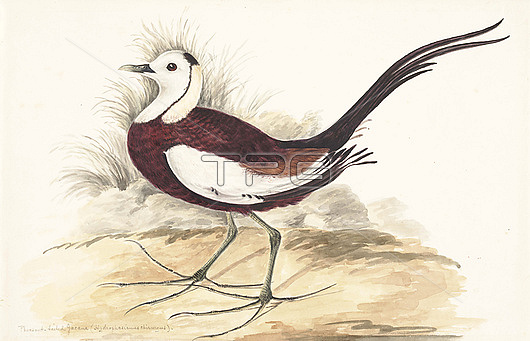
Illustration of a pheasant-tailed jacana (Hydrophasianus chirurgus), a jacana in the monotypic genus Hydrophasianus. Like all other jacanas they have elongated toes and nails that enable them to walk on floating vegetation in shallow lakes, their preferred habitat. They may also swim or wade in water reaching their body while foraging mainly for invertebrate prey. They are found in tropical Asia from Yemen in the west to the Philippines in the east and move seasonally in parts of their range. They are the only jacanas that migrate long distances and with different non-breeding and breeding plumages. The pheasant-tailed jacana forages by swimming or by walking on aquatic vegetation. Females are larger than the males and are polyandrous, laying several clutches that are raised by different males in their harem. 18th century watercolor painting by Lady Elizabeth Symonds Gwillim (1763-1807). Lady Gwillim painted a series of about 200 watercolours of Indian birds. Produced about 20 years before John James Audubon, her work has been acclaimed for its accuracy and natural postures as they were drawn from observations of the birds in life.
| px | px | dpi | = | cm | x | cm | = | MB |
Details
Creative#:
TPG32656948
Source:
達志影像
Authorization Type:
RF
Release Information:
須由TPG 完整授權
Model Release:
N/A
Property Release:
N/A
Right to Privacy:
No
Same folder images:

 Loading
Loading